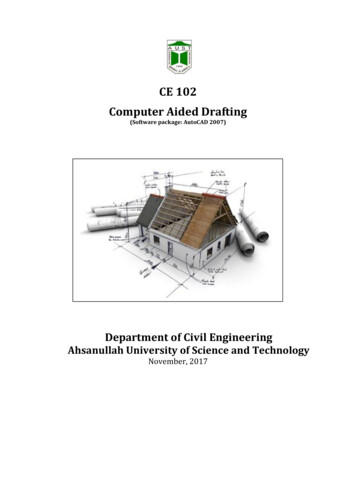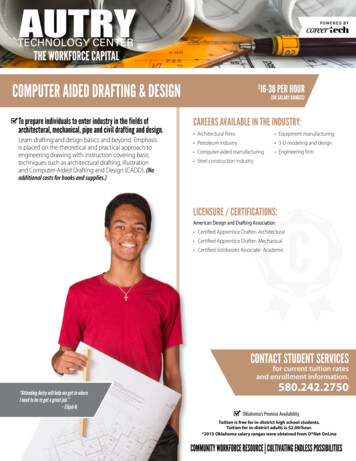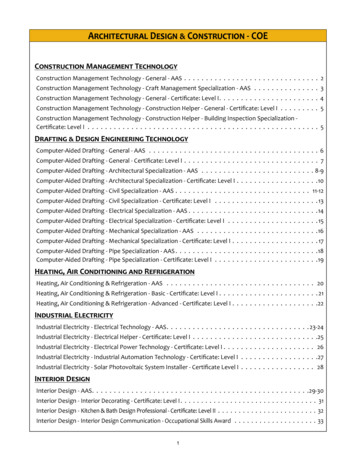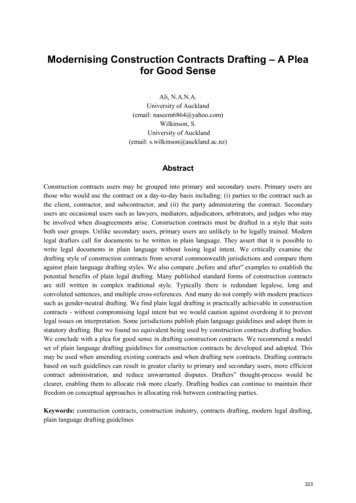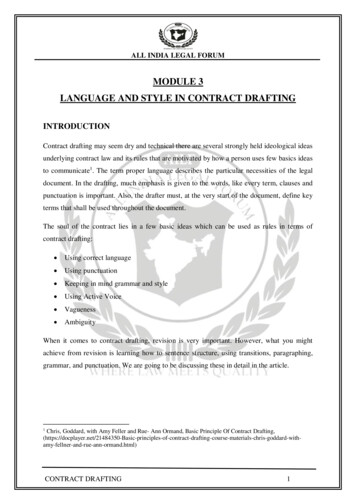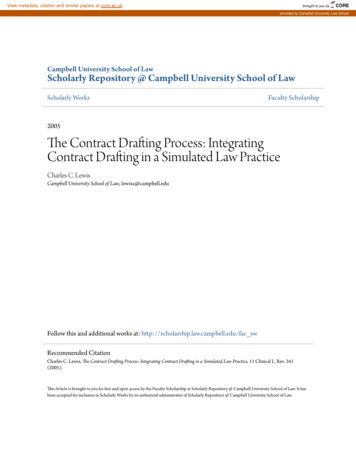
Transcription
View metadata, citation and similar papers at core.ac.ukbrought to you byCOREprovided by Campbell University Law SchoolCampbell University School of LawScholarly Repository @ Campbell University School of LawScholarly WorksFaculty Scholarship2005The Contract Drafting Process: IntegratingContract Drafting in a Simulated Law PracticeCharles C. LewisCampbell University School of Law, lewisc@campbell.eduFollow this and additional works at: http://scholarship.law.campbell.edu/fac swRecommended CitationCharles C. Lewis, The Contract Drafting Process: Integrating Contract Drafting in a Simulated Law Practice, 11 Clinical L. Rev. 241(2005).This Article is brought to you for free and open access by the Faculty Scholarship at Scholarly Repository @ Campbell University School of Law. It hasbeen accepted for inclusion in Scholarly Works by an authorized administrator of Scholarly Repository @ Campbell University School of Law.
THE CONTRACT DRAFTING PROCESS:INTEGRATING CONTRACT DRAFTING INA SIMULATED LAW PRACTICECHARLES C.LEWIS*Teaching contract drafting in the classroom has been troublesome ever since it became a part of the law school curriculum. Drawing on the author's experience in teaching the course, as well as hisexperience as a former practicing lawyer, this essay proposes thatcontract drafting can be more effectively taught in the classroom byusing a simulation model that allows the students to learn contractdrafting as lawyers experience it in actual practice. In the simulation,the students experience not only traditionalcontract drafting, but alsothe interviewing, planning, and negotiating that are essential to successfully drafting a contract. In addition, the students must deal withthe client and opposing counsel, as well as co-counsel and a seniorpartnerassigned to the same project. While the students are handlinglegal issues in their office files, they must also face ethical and malpractice issues, and even law office management issues.INTRODUCTIONA law school course in contract drafting is a valuable part of thecurriculum. Judging from the contract drafting texts available todayfor classroom use, the course covers a wide range of drafting topics'* Professor of Law, Norman Adrian Wiggins School of Law, Campbell University. Iwish to thank Professor (formerly Dean) F. Leary Davis for introducing planning coursesinto the law school's curriculum and Professor Richard A. Lord who first taught contractplanning and handed over to me the foundation of the course that I subsequently developed and now describe in this essay. I also wish to thank Dr. J. Stanley McQuade forreading and commenting on an earlier version of the essay and Professor Dale A. Whitman, a former president of the Association of American Law Schools, who unknowinglyspurred me on to write this article when I read his article, "Clinics for the Rest of Us,"published in the November 2002 AALS newsletter, in which he pleads for the developmentof clinical and simulated clinical experiences in transactional lawyering to complementpresently existing litigation-oriented clinics. Finally, I wish to thank Wallace N. Tiffany andW.N. Tiffany, Jr., whose influence over me as a young practicing lawyer is reflected in thisessay and continues with me today.1 A drafting course might include topics such as the overall drafting process, the organization of a contract, drafting style and usage, rules of contract interpretation, concernsabout boilerplate and other standard provisions in contracts, a review of contract law,drafting ethics, document review, drafting by computer, as well as how to write definitions,how to avoid ambiguity, when to use vagueness, and how to use contract forms. See, e.g.,SCOTT J.BURNHAM, DRAFTING AND ANALYZINGCONTRACTS (3d ed. 2003); THOMAS R.(2003); GEORGEHAGGARD, LEGAL DRAFTING: PROCESS, TECHNIQUES, AND EXERCISESHeinOnline -- 11 Clinical L. Rev. 241 2004-2005
CLINICAL LAW REVIEW[Vol. 11:241and provides law students with practical information they can use indrafting legal documents, as well as a chance to practice what theylearn by reviewing or drafting documents in class exercises.When taught by the traditional classroom method, 2 the courseprovides a good foundation for a law student's education in contractdrafting. Although some courses in contract drafting may be limitedto teaching students how to put their client's agreement effectively onpaper, other courses may include some instruction on the planningthat needs to precede the actual drafting of the contract. But something is nevertheless missing. Teaching contract drafting, even with aplanning component, is teaching only a part of the broader processinvolved in producing a written contract between parties. Teachingonly a part of the process does not provide the foundation studentsneed for understanding the entire process.Teaching contract drafting in the traditional manner, by assignedreadings, classroom lectures and discussions, and even drafting exercises, is not the most effective method to use. Instead, contract drafting can be taught more effectively by integrating it into the context ofa simulated law practice. In an actual practice, the contract draftingprocess begins with a client contacting the lawyer about drafting acontract and ends sometime later when the parties come to an agreement on the terms and sign the contract. 3 Between the client's initialcontact and the subsequent signing of the contract, far more goes onthan the mere drafting and planning of a contract, and much of whatgoes on will profoundly influence the drafting of that contract. Thecore of the drafting course that I teach is the interviewing for and theplanning, negotiating, and drafting of a relatively complex contract inthe context of a simulated law practice. By integrating contract drafting into the context of a law practice, students learn contract draftingas lawyers experience it, and they have an opportunity to understandhow it fits within the broader contract drafting process.I took an elective course in contract drafting as a student in lawschool. Some thirty years later, I only remember looking at varioustypes of contracts that were passed around in class as examples.Surely there must have been more to it than that, but that is all that Iremember about the course. I do not remember using any part of thecourse in my law practice after I graduated. I learned what I knowW. KUNEY, THE ELEMENTS OF DRAFTING(2003).2 For an example of a traditional method of teaching legal drafting, see REED DICKERSON, THE FUNDAMENTALS OF LEGAL DRAFTING 359 (2d ed. 1986).3 It could begin earlier if the parties begin negotiating the terms of the contract beforecontacting the lawyers, and it could extend beyond the signing of the contract if the partiessubsequently modify the contract.HeinOnline -- 11 Clinical L. Rev. 242 2004-2005
Spring 2005]Integrating Contract Drafting in a Simulated Law Practice243about contract drafting in the same manner that I suppose most lawyers have learned it - in practice.After practicing for a number of years, I became a law professorand was eventually assigned to teach an elective contract draftingcourse in the late 1980's. It was ironic that I was assigned to teach acourse that did little for me in law school or practice, and I beganteaching it with considerable misgiving.I soon discovered that contract drafting had come a long waysince the late sixties and early seventies when I was in law school. Thedrafting course as conceived by our then dean, F. Leary Davis, wasbroader than a mere drafting course. It was labeled "Contract Planning," and it was designed to contain a planning component to accompany the traditional drafting component of the course. The idea, ofcourse, was to get at the planning behind the drafting of the contract,as well as at the actual drafting itself. The casebook used in the coursewas a first year contracts casebook, but it included a section of casesand materials that allowed the students to examine what drafters haddone wrong in drafting a contract. 4 This section was designed to makethe students think about what the drafters could have done to avoidlitigation or to bring about a more favorable result in litigation.In addition to assignments in the casebook, the students weregiven, as a practical exercise, a short summary of a proposed commercial transaction with directions to plan and draft a contract satisfactoryto both sides of the contract. Two students were assigned to representeach side of the contract. The students were directed to make up reasonable terms for their clients and then negotiate those terms with theother side. The goal of this simulated project was to draft a contractthat both sides could recommend to their clients for signing.I taught the class by this method for several semesters before Idecided to make the course more relevant to practice. My solutioncame partly from my experiences as a professor when I taught lawschool courses or judged competitions that used simulation to teachlawyering skills. In particular, I had observed how client counselingcompetitions included the simulation of interviewing and counseling,often with a view towards drafting a document for the client, and Ibegan to realize how simulation of an interview might help in teachingthe contract planning process.My solution also came from my experience in teaching a law office management course that reminded me of the experiences I had asa new lawyer. At that stage of my career, I tried to work successfullywith many different people, some of whom naturally represented in4 IANR.McNEIL, CONTRACTS: EXCHANGE TRANSACTIONS AND RELATIONS1978).HeinOnline -- 11 Clinical L. Rev. 243 2004-2005(2d ed.
CLINICAL LAW REVIEW[Vol. 11:241terests adverse to the interests of my clients. I struggled to get mywork done competently and on time and to keep my files documentedand up-to-date. I worried about doing something legally or ethicallywrong and, as a consequence, cutting short my legal career. Thesememories reminded me that the contract drafting process does nottake place in the serene isolation of a private office but instead in thehurly-burly of law practice.As a result, I decided to teach contract drafting by integrating itwithin the setting of an ongoing law practice, where the lawyer has aclient to be interviewed, consulted, advised, and kept up to date, aswell as a senior partner who supervises the work, an associate withwhom to work, and opposing lawyers with whom the contract must benegotiated successfully. I wanted the students to confront and learnto handle the legal, ethical, and other issues that confront practicinglawyers. In short, I wanted to teach contract drafting the same way Ilearned it - not by reviewing drafts or drafting them in class, but bydrafting a contract in the same fashion as a lawyer in practice.Instead of having students make up the facts for the project as inthe previous course, I would require that they wrestle the facts out ofa simulated client interview, just as practicing lawyers must do. Instead of having students draft in class a contract conforming perfectlyto a client's interests, I decided to put the students through a simulated negotiation process that involved opposing lawyers (students)representing the other client's interests, a process that would resultnot in the perfect contract but in the best contract under thecircumstances.I also wanted the students to experience those working relationships that shape their work in the law practice. In the existing coursedesign, they experienced working with another person in the projectbecause I assigned two students to represent each client, but I alsowanted them to experience a working relationship with a senior partner who assigns and supervises their work, discusses issues and possible solutions, and reviews and critiques contract drafts. I also wantedthem to have a continuing relationship with the client and also withthe lawyers (students) representing the client on the other side of thecontract.Finally, I wanted the students to use an office file to documentthe work that a practicing lawyer does in planning, drafting, and negotiating a contract. I wanted the file to reflect their working relationship with their senior partner, their student partner, the client, and theopposing lawyers, to show how the students handled the ethical andlegal issues that inevitably arise in the drafting of a contract, and toreflect how they protected themselves from the threat of legal mal-HeinOnline -- 11 Clinical L. Rev. 244 2004-2005
Spring 2005]Integrating Contract Drafting in a Simulated Law Practice245practice or ethical malfeasance. By all of these means, I hoped to integrate contract drafting into the broader context of the practice oflaw.In this essay, I describe what I do in class to prepare my studentsfor the simulated drafting project that forms the core of the course. Ithen describe the simulated project in each of its phases and explainhow each phase of the project integrates contract drafting into thecontext of a law practice. Finally, I point out the educational benefitsthat are derived from each phase and describe a number of other educational benefits that appear to flow from the simulated project as awhole rather than from any individual phase of the project.I.PREPARING FOR THE SIMULATED DRAFTING PROJECTThe course is a two hour course. Instead of teaching it two hoursa week, however, I teach it three hours a week for two-thirds of thesemester, leaving the last third of the semester with no classes. Byconcentrating the class hours during the first part of the semester, Iam able to teach the students what I want them to do in the simulatedproject. Class hours at the end of the semester have less value sinceby that time the students need to know how to do the work necessaryto complete the simulated project. I do, however, spend considerabletime during the last third of the semester reviewing their files and advising them as they complete the project. The students' work in theproject determines their course grade; no exam is given.I begin the course by teaching an interviewing component sinceno drafting can take place until the lawyer interviews the client andelicits the facts needed to plan, negotiate and draft the contract. Inteaching this component, I assign materials on interviewing for thestudents to read outside of class, and I then talk about interviewing inclass. 5 I next have the class apply what they have learned by interviewing me as I play the role of a client who is about to make a business loan to a relative. 6 The students use the three-stage interviewingprocess 7 that we have discussed in class and which they will use againin the simulated project. During the course of the interview, I occasionally step out of the client role to connect what they have learnedin class with what is taking place at that moment in the interview.5 I emphasize to the students that this course is not a course in interviewing, and Iencourage them to take a course in interviewing and counseling, either in the law school orin a continuing legal education program.6 1 play the part of a blue-collar worker who has agreed to make a substantial loan to anephew who will use the money to start a business that is unlikely to succeed.7DAVID A. BINDER & SUSAN C. PRICE, LEGAL INTERVIEWING AND COUNSELING54 (1977).HeinOnline -- 11 Clinical L. Rev. 245 2004-200553-
CLINICAL LAW REVIEW[Vol. 11:241When the interview is over, the students must use their interviewnotes to prepare a detailed summary of the facts they have learned inthe interview.The students must then analyze those facts in the planning component of the course. To prepare the students for this component, Iintroduce in class the classic planning questions that ask where theclient wants to be, where the client is now, and what must be done toget the client where he wants to be. 8 In determining the answers tothe first and second questions, the students must identify the goals ofthe client and then assess the client's strengths and weaknesses in attaining those goals. In determining the answer to the third question,they must identify the performance terms that describe what the parties must do in carrying out their obligations under the contract. Inaddition, the students must predict any obstacles to carrying out thoseperformances 9 and suggest how drafting might eliminate those obstacles. They must foresee any terms needed in the agreement to protectthe client in the event of a breach of a term of the contract, or toprotect the client against some external risk that may threaten thecontractual arrangement. 10 I also ask the students to list any ethicalissues that arise from the interview, any legal concerns that need to beresolved by legal research, and the advice they should give to the client based upon their planning.After learning about the planning component in class, the students must use what they have learned by analyzing the facts theyhave elicited from me in the interview. They individually review thefacts outside of class and identify the client's goals, the client'sstrengths and weaknesses, and the performance terms needed in thecontract. They review the performance terms to suggest any necessaryadjustments to avoid any obstacles to the parties' future performances, and they set out the terms that will protect the client in theevent of breach. Finally, they list their ethical and legal concerns andtheir advice for their client. We discuss their planning work in class,and the students eventually recommend that the client should use anegotiable promissory note to document the proposed loan to the relative. Although we have not yet talked about drafting in class, I haveeach student draft a promissory note that reflects the planning we previously discussed in class.After the students have drafted their notes, I hand out in class anote that I have drafted so that the students can compare their notes8 F. Leary Davis, Strategic Planning Using a Computerized FinancialModel, Part 1, 824 (1989).9 McNeil would likely label this "performance planning." McNEIL, supra note 4, at 24.10 McNeil would likely label this "risk planning." See id. at 25.LEGAL MGMT.HeinOnline -- 11 Clinical L. Rev. 246 2004-2005
Spring 2005]Integrating ContractDrafting in a Simulated Law Practice247to mine, and we discuss each provision of my note from a planningrather than a drafting perspective. For example, the client had suggested in the interview that the note should be payable at the end ofthe year in one lump sum. Based on the planning by the class, however, we typically decide to draft our note as an installment note withequal monthly payments spread out over a one year term. The classsuggests this change in order to make it easier for the relative to repaythe money, and, at the same time, to allow the client to get most of themoney back before the end of the year. Also, since we have draftedthe note as an installment note, we include an acceleration clause inthe note to protect the client if the relative defaults on an early installment and the client wishes to sue immediately for the full amount ofthe note rather than waiting for each payment to become due. By firstplanning the note and then drafting its terms based on that planning,the students are able to understand how terms are drafted or added toa contract for particular reasons and not just because a form contractuses the term or the term appears important to the drafter.While planning the terms of the promissory note, the studentsrealize how much law is involved in drafting a simple promissory note.They must face the concept of negotiability, along with accelerationclauses, attorney fee clauses, waiver clauses, and prepayment clauses,and also consider the effect of usury on the promissory note. They seehow the planning component and the knowledge of law affect thedrafting of a contract, and they realize that they cannot draft a contract without a good working knowledge of the law involved.The next component for the class is the negotiation component. Iassign the students some materials to read on negotiation before class,and then we talk about negotiation in class." I then have the studentsapply what they have learned in class by requiring them to negotiatethe terms of a simple commercial transaction outside of class in a oneon-one negotiation. For this practice negotiation, I give each studenta fact sheet setting out the information needed for a negotiation withanother student who represents the other side. Before the negotiationbegins, I require the students to analyze their facts in the light of theplanning component and to give the opposing student a letter settingout the performance terms for the contract. With their planning freshin their minds, they then negotiate those terms outside of class andprepare a summary of the negotiation. Since the students have negotiated the same commercial transaction, we discuss the results of theirnegotiation in class. In that discussion, I connect what they have11As I do in the interviewing component, I emphasize to the students that this course isnot a course in negotiation, and I encourage them to consider taking a course in negotiation, either in law school or in a continuing legal education program.HeinOnline -- 11 Clinical L. Rev. 247 2004-2005
CLINICAL LAW REVIEW[Vol. 11:241learned in class to what took place during their negotiations. I alsopoint out how the use of planning prior to the negotiation, as in identifying the client's goals, strengths and weaknesses, and performanceterms, should have helped the students in preparing for negotiationand in the negotiation itself.We next move to the drafting component. The students are assigned readings from the drafting text used in the course, and they doa drafting exercise on their own to practice what they have learned. 12The focus of discussion in class, however, is on a contract that incorporates many of the drafting issues raised in the assigned readings. Thestudents first review the contract on their own, identifying issues andcorrecting problems raised by those issues, and then we go over thecontract in class. Each issue raised in the contract provides a way forme to talk about good drafting in the light of the assigned readings.After completing the drafting component in class, the studentsare then ready for the entire simulated project. In my course, however, I allow the students to begin a phase of the simulated projectimmediately after we have covered the applicable component for thatphase in class. For example, when we finish the interviewing andplanning components in class, the students then start the interviewingand planning phase of the simulated project, while I go on to the negotiation component in class. When the negotiation component iscompleted in class, the students begin the negotiation phase of theproject, while I go on to the drafting component in class. As a result,the students engage in each phase of the project when the classroominstruction on that phase is still fresh in their minds. The simulatedproject has four phases, and they are described below.II.THE SIMULATED DRAFTING PROJECTTo begin the simulated project, I divide the class into teams oftwo. Each team is paired with another team so that each team canrepresent a client on opposite sides of the transaction. I limit the classto a maximum of 24 students, so I have no more than 12 teams of twostudents negotiating six contracts at a time. I use no more than threefactual situations, so that in managing six contract negotiations, I amworking with only three sets of facts. Since I use more than one simulation, students can play the role of the client in a simulation in whichthey are not assigned a lawyer role.12 1 use the CALI lesson entitled, "Drafting a Contract - the Sale of Goods" for theexercise. This interactive lesson works well as an outside assignment since it provides itsown feedback.HeinOnline -- 11 Clinical L. Rev. 248 2004-2005
Spring 2005]Integrating Contract Drafting in a Simulated Law PracticeA.249Phase One: Interviewing and PlanningPrior to beginning the interview, the students receive a memo setting out general guidelines to follow in conducting the interview. Forexample, the interviewed students must, within reason, answer onlythe questions asked and not immediately reveal all the information onthe fact sheet as a result of an overly broad question. If they areasked a question that is not answered on the fact sheet, they are instructed to say, "I don't know." The interviewing students should notask, "What terms do you want in the contract?" or "Do you want aliquidated damage clause?" Instead, they should determine whatclauses should be included based on the facts they get from the interview. Both interviewing and interviewed students must use the threestage interviewing process practiced earlier in class, but the interviewing students may also use any appropriate checklist of questions oreven a form contract to ask other questions.To begin the interview, each team is given an assignment sheetthat provides a brief outline of a proposed contract. As an example,one team gets an assignment sheet explaining that their client manufactures dump trucks and is interested in obtaining a steady supply ofdiesel engines for their trucks from an engine company they have contacted but never dealt with before. The team on the other side getsthe assignment sheet explaining that their client manufactures andsells diesel engines and has been contacted by the dump truck company about buying diesel engines to install in its trucks. Each teammust then interview its client to learn the additional facts relating tothe proposed contract.I give the students playing client roles a fact sheet that containsthe information necessary to fill in most of the gaps in the facts contained in the assignment sheet. The fact sheet for the dump truckmanufacturer provides specific information about the client, its manufacturing facilities, its problems with its present supplier of engines,what it expects to gain in a contract with a new supplier, and somegeneral information about the potential new supplier. The fact sheetfor the manufacturer of diesel engines provides similar informationfor the seller. The fact sheets reflect the information that might begained in a typical first interview and provide ample facts for the interviewing students to use in the subsequent planning component ofthe simulated project.The interviewing time is limited to one hour. If the interviewingstudents finish the interview in forty minutes, they may schedule afollow-up interview for the remaining time to ask questions occurringto them after an initial interview. At the end of an hour, or earlier ifthere are no more questions, the interviewing students may ask theHeinOnline -- 11 Clinical L. Rev. 249 2004-2005
CLINICAL LAW REVIEW[Vol. 11:241interviewed student what facts they missed. 13 If the students are stillnot convinced that they have all the facts they need, they then come tosee me, and I take up the role of the client to answer their questions.I make the interview as realistic as possible, and thus I do notinclude in the fact sheet all the facts needed for drafting the contract.As a result, the interviewing students must experience the "I don'tknow" answer that occurs so frequently in actual interviews. For example, each student interviewed is an agent of a business entity referred to in the fact sheet as a "company." No information is given onthe fact sheet as to what kind of business entity the company is, nor isthere sufficient information for the interviewing students to concludethat the agent has authority to act for the principal. The interviewingstudents must then decide whether the missing facts are importantenough to pursue. If they decide they need the additional facts, theymust come to me for that information since I have become their clientat that point. By the end of the interviewing process, they should understand that what they learn in an initial interview does not typicallycomplete the interviewing process and that they alone have the responsibility to pursue any loose ends from an interview.As in real life, some facts obtained in the interview appear irrelevant to the students and are frequently omitted from any documentation in the file. As the students continue in the project, they mayaffirm that conclusion, but, again as in real life, some facts that appearirrelevant may later turn out to be important. In one fact situation, Iprovide facts indicating that no bulk transfer will occur in the transaction. Since most students have never heard of a bulk transfer, or theproblems it can create, the facts appears irrelevant to them. Once theissue of a bulk transfer is raised and the students do some legal research, however, those facts become relevant in determining whetherthe buyer should be protected in the contract by terms addressing thebulk transfer. In emphasizing the need to play it safe in these situations, I have instructed the students to be inclusive rather than exclusive in taking notes during the interview because they cannot alwaystell what facts may be important in the future as the transactiondevelops.1413 I allow this release of information because it is important that the students get all theinformation to plan the contract effectively; it also gives the interviewing students somefeedback about how effectively they conducted the interview. In addition, the studentsrepresenting the other side do not suffer because of poor fact gathering by the opposingside. Finally, I learn what the interviewing students missed in the interview because theinterviewed student returns to me the fact sheet with the missed information highlighted.14 I find that students are inclined to exclude any information that appears irrelevantfor their present purp
contract drafting can be more effectively taught in the classroom by using a simulation model that allows the students to learn contract drafting as lawyers experience it in actual practice. In the simulation, the students experience not only traditional contract drafting, but also the inter


